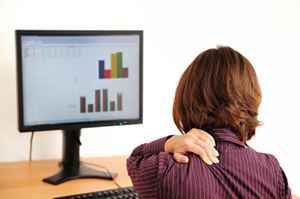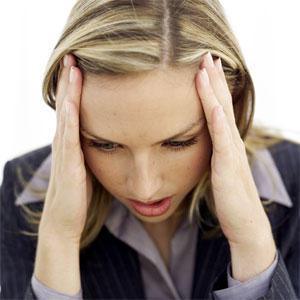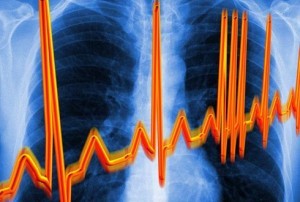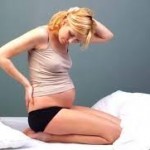
Osteochondrosis is rightly considered a "disease of the century" today, because in most cases it affects people whose work does not require increased physical activity.
In most cases, changes in cartilage and bone tissue are observed in people of working age up to 40 years.
The disease can affect different parts of the spine and is the second most common cervical spine osteochondrosis.
What is this?
Osteochondrosis is a degenerative disease of articular cartilage and adjacent bone tissue.
Previously, the term was applied to a large group of osteoarticular diseases, but now it is used only for degenerative diseases of the spine.
Compared to other parts of the spine, the cervical region is the most mobile and has many nerve and vascular formations. When the structure of the vertebrae is small, but also surrounded by a weak muscular corset.
This anatomical structure predisposes to the development of osteochondrosis, which depends on the severity of clinical manifestations, the nature of the changes in the intervertebral discs and the degree of destruction.
Causes of the disease
The main and most common cause of cervical spine osteochondrosis is a sedentary lifestyle.
Due to the lack of physical activity with a sedentary and sedentary lifestyle:
- metabolic processes are disrupted;
- levels of salts in the bloodstream and lymph fluid increase;
- Salts are formed in the cervical spine, kidneys and liver.
Damage to the cervical vertebrae is mainly caused by malnutrition in the intervertebral discs. Therefore, proper and unbalanced diet is one of the main causes of cervical osteochondrosis.

Risk Factors
There are many risk factors for cervical osteochondrosis.
The most common factors are:
- heredity;
- age-related changes;
- cervical spine injuries;
- hypothermia;
- hormonal diseases that cause metabolic disorders;
- Some autoimmune diseases that damage cartilage tissue (systemic lupus erythematosus, rheumatism).
Why is it dangerous?
Not only the spinal cord and nerve roots pass through the cervical spine, but also the vertebral artery, which is responsible for supplying blood to the brain, medulla oblongata and the back of the cerebellum.
Therefore, with cervical osteochondrosis, this artery is constricted, resulting in impaired cerebral circulation.
In highly advanced cases, constriction of arteries and adjacent blood vessels and nerve plexuses can lead to the following consequences:
- lack of coordination;
- hearing and vision loss;
- stroke.
If left untreated, the disease can lead to complications such as dislocation of the intervertebral disc or herniated disc.
Disease progression
Cervical osteochondrosis, like osteochondrosis of other parts of the spine, develops in stages. There are 3 stages in the development of the disease.
1 degree
It is characterized by the beginning of the destruction of intervertebral discs.
Cracks appear in the annulus fibrosus, the strength and elasticity of the disc is impaired, the height is reduced, so the nerve roots are compressed.
Characteristic aching pain appears. Sometimes in stage 1 (preclinical) there is no such pain, and osteochondrosis occurs with moderate discomfort in the neck.
2nd degree
When grade 1 osteochondrosis is left untreated or treatment is ineffective, a chronic condition called grade 2 osteochondrosis occurs.
The pain is persistent, the intervertebral disc continues to be destroyed and compressed, causing minor dislocations of the cervical vertebrae.
At this stage, cervical osteochondrosis can lead to head syndrome. This syndrome is characterized by severe pain, and a person must keep his head in a stable position to reduce pain.
3rd degree
Grade 3 cervical osteochondrosis is accompanied by the following symptoms:
- headaches;
- nausea;
- dizziness;
- neck "lumbago";
- Sensitivity disorder in the upper extremities.
Anulus fibrosis is almost destroyed, which leads to complications of osteochondrosis - a protrusion of the intervertebral disc or intervertebral hernia.
In stage 3 osteochondrosis, the intensity of pain can be reduced because the affected cartilage tissue in the intervertebral disc simply does not exist, ie there is no source of pain, however, nerve root compression remains, so the pain does not go away completely.
Signs and Symptoms
There are many symptoms of this disease. And it depends on which vertebrae are damaged by this disease.
Typical syndromes in cervical osteochondrosis are:
- radical syndrome;
- vertebral artery syndrome;
- cervical migraine syndrome;
- hypertensive syndrome.
All these syndromes are accompanied, first of all, by different types of pain.

Given vertebral artery syndrome, headache manifests itself in the early stages of the disease.
In this situation, pain attacks may be accompanied by:
- dizziness;
- unstable gait;
- visual symptoms (fog in front of the eyes, decreased visual acuity, etc. ). fainting (with sudden head movements).
Hypertensive syndrome is defined as an increase in intracranial pressure.
Headache is more explosive and may be accompanied by nausea and vomiting. With exacerbation of cervical osteochondrosis, an increase in temperature and an increase in ESR can be observed.
The following neurological symptoms may occur when the spinal cord is compressed ("radicular syndrome"):
- severe pain in the neck (cervical);
- neck pain spreading to forearm and humerus (cervicobrachialgia);
- pain in the arm;
- cracking or cracking sensations in the neck when turning the head;
- "radiating" pain in the ear that occurs after a long stay or a sudden movement that causes discomfort;
- sore throat or a lump in the throat, respiratory problems;
- combination of hands and tongue;
- feeling of swelling of the tongue;
- severe weakness;
- hearing and vision impairment;
- tinnitus;
- general deterioration of health.
In cervical migraine syndrome, there is irritation of the sympathetic nodes, which leads to impaired reactivity of cerebral vessels and circulatory disorders.
Frequent hypertension may develop as a result:
- ears clogged;
- tachycardia;
- noise at the beginning;
- ring in the ears.
Spinal cord injury can occur when the arteries that supply the spinal cord become constricted.
Circulatory disorders in the brain with osteochondrosis can lead to:
- lack of oxygen to brain cells;
- mental illness (depression, panic attacks);
- Symptoms of epilepsy, such as short-term loss of consciousness and tension in the whole body - these are often confused with symptoms of epilepsy.

A very common symptom of cervical osteochondrosis is changes in heart rhythm and disturbances, such as extrasystole or arrhythmia.
These symptoms are very common among drivers and office workers.
Due to a sedentary lifestyle, changes occur in the intervertebral discs of the cervical and thoracic spine, which leads to disorders of the heart.
In most cases, it is impossible to get rid of arrhythmias until osteochondrosis is treated.
Edema under the eyes can also indicate cervical spine osteochondrosis.
Often they depend on the condition of the head during sleep at night, disappear during the day and cause headaches, dizziness, heaviness in the head, etc.
Vegetovascular dystonia is one of the most common diseases caused by this disease.
It is the result of constricted arteries running along the edges of the spine.
Diagnostic methods
The initial diagnosis is made by a neurologist during the initial examination of the patient. Recently, the doctor had to make a diagnosis only by conducting an external examination of the patient and sending him for an X-ray examination.
Unfortunately, it is not possible to see the full picture of the disease on X-ray.
At present, there are tests such as computed tomography and magnetic resonance imaging, which can fully assess the stage of development of the disease.
Once diagnosed, the patient is referred to a physician who specializes in this area.
Which doctor treats?
Treatment is performed by a specialist with a narrow focus - a vertebrologist or vertebroneurologist.
Treatment of cervical osteochondrosis
The severity of the main clinical symptoms is the basis for the treatment of cervical osteochondrosis.

Symptoms in the cervical spine are mainly associated with constriction of blood vessels and nerve endings, so during treatment they primarily eliminate edema and restore blood circulation.
There are many treatments used to treat cervical spine osteochondrosis.
The most effective treatment is a combination of several conservative treatment methods.
Complex treatment of cervical osteochondrosis can include the following traditional and non-traditional methods: drug therapy, massage, acupressure, manual therapy, physiotherapy, acupuncture, homeopathy, folk remedies, etc.
The main stages of treatment of osteochondrosis are the same for all localizations of the disease:
- First you need to reduce the pain.
- Then the swelling will be removed.
- At this stage it is necessary to normalize blood circulation.
- Strengthening the muscle corset.
- Improving nutrition and tissue regeneration.
Only a good team of specialists, including a neurologist, physiotherapist, massage therapist, surgeon and vertebral neurologist, can select the most appropriate therapy.
Like any disease, cervical osteochondrosis should be treated in the early stages. If you do not start the process, you can achieve a complete cure of osteochondrosis at this stage.
Unfortunately, stages 2 and 3 of cervical osteochondrosis are accompanied by complete or partial destruction of the intervertebral discs, so these stages are characterized by a very long recovery process.
First Aid
How to relieve pain during exacerbation?
In case of severe pain, you should take painkillers from your medicine cabinet at home: they can be analgesic. You can also apply pepper plaster for pain.
Diuretics may be taken if swelling occurs. Rubbing the neck with painkillers can help.
You can also use theneedle applicatorfor pain:
- relieves back pain;
- reduces muscle spasm;
- stimulates the work of internal organs;
- normalizes blood circulation.
Physiotherapy and warming are contraindicated in exacerbations, as these effects can lead to serious complications.
After relieving acute pain, you should consult your doctor immediately for advice.
Drug Treatment
Drug treatment usually begins with injections (in case of inflammation), then switches to tablets and suppositories with local application of ointments and gels.
During drug treatment, anesthesia is performed with steroid anti-inflammatory drugs.
It is important to prescribe drugs that restore cerebral circulation.
Muscle relaxants can be prescribed for pathological muscle tension. For a more effective treatment, vitamins are taken in therapeutic doses and trace elements.
In cases of intervertebral hernia, surgery is often recommended and the attending physician may suggest surgery.
Massage and self-massage
This method works well with physical therapy and physiotherapy. You can get a massage course both in any medical institution and by contacting special applications.
Massage is needed to strengthen the muscles of cervical osteochondrosis and relieve tension in the neck.
The task of the masseur is to eliminate harmful metabolic products by increasing blood flow and flow in the diseased area, and at the same time to eliminate spasms in the pathological area.
The main methods used by experts in neck massage are:
- caress;
- squeeze;
- rub;
- vibration;
- kneading.
Self-massage techniques can be performed using the following methods:
- stroking (movements should be gentle, without much effort, wrinkles)
- kneading (deep impact on the muscles, holding without bending, pressing and pressing);
- vibration (vibrating effect of beating, shaking, hitting).
Self-massage should always end with caressing. You can use a massager during the vibration.

Acupressure massage
Acupressure massage relieves headaches during the exacerbation of cervical osteochondrosis, helps to increase and normalize blood pressure.
Acupressure scheme:
- 1 minute exposure to the feng fu point under the occipital protrusion.
- Influence of mastoid processes on the feng chi point, which is two fingers wide.
- 1-1, 5 minutes impact on the ya-men point (three fingers away from the feng-fu point).
- At the Da-chzhui point (7th cervical vertebra) 1-1. 5 minutes of sedation.
You may need to lie down for a few minutes after acupressure, as you may experience mild dizziness.
Manual therapy
Manual therapy helps to cope with both acute and chronic pain, while increasing the level of movement and improving posture.
Basic methods of manual therapy for cervical spine osteochondrosis:
- Relaxing and segmental massage.Used to warm up muscles and relieve tension.
- Mobilization.Effects on restoring joint function by traction.
- Manipulation.A sharp push towards the patient's pathological areas. The procedure is accompanied by a characteristic crisis (return of the joint to normal).
A manual therapist should be familiar with these techniques. Otherwise, any mistake can cause damage.

Acupuncture
Acupuncture helps release cortisol into the bloodstream. This hormone has a clear anti-inflammatory effect.
Acupuncture is performed by applying points close to the inner edge of the scapula. The needles are placed at a depth of 1 to 2 cm and left to move for 10 to 30 minutes.
Homeopathy
Medication has many negative side effects, so homeopathy can be a worthy substitute for treatment without unwanted consequences.
Nutritional Features
Food is rich in calcium and magnesium.
These trace minerals are found in fish and seafood, nuts, legumes and dairy products.
Osteochondrosis of the neck can often be accompanied by atherosclerosis. In this case, a strict diet is recommended.
The diet is set for 3-4 months. It is necessary to limit the consumption of all foods that contain cholesterol. These include animal fats, fatty meats, fatty dairy products, etc. You should also limit or exclude the consumption of salt, sugar and flour products.
It is recommended to give up bad habits (smoking, alcohol, etc. ).
Cervical osteochondrosis and alcohol are related. The truth is that getting into the bloodstream destroys the cells of alcohol, thereby aggravating the already disrupted blood circulation in osteochondrosis.
Therefore, you should minimize and completely stop drinking alcohol during an ignition.
Disease Prevention
To prevent cervical osteochondrosis, it is recommended to follow the following rules:
- sleep should be on a firm mattress and low pillow: the angle of bending of the neck should not exceed 15 degrees;
- Take a hot shower for at least 10 minutes every day;
- Visit the sauna and bath as often as possible: heat helps to relieve neck spasms;
- Give yourself low-speed aerobic activity and regular walks;
- go swimming;
- After 25 years, avoid the shock load of the spine (jump, run);
- Be sure to take five-minute breaks every hour while sitting;
- Regular yoga practice can prevent any manifestation of cervical osteochondrosis;
- Refuse to go to the gym, because bodybuilding can cause cervical disc protrusion;
- Exercise, such as prevention of osteochondrosis of the neck, helps to strengthen the neck muscles and reduce tension.
Frequently Asked Questions
What to do during pregnancy and how to treat it?
Often the first symptoms of cervical osteochondrosis appear during pregnancy.

This is due to changes in hormonal levels and softening of the spine, as well as a change in the center of gravity and excessive stress on the spine.
The treatment of osteochondrosis in pregnant women is very complicated, as it is limited to drugs that are mainly aimed at reducing pain.
You can apply natural ointments or resort to traditional medicine.
Any impact on the neck area (warming up, exercising, etc. ) during pregnancy is prohibited.
Does it occur in children and adolescents?
In children and adolescents, cervical osteochondrosis develops due to congenital or acquired functional deficiency of cartilage tissue.
Complains of headache, fatigue, dizziness and fainting.
Is it possible to heat the neck area?
Warming of the neck with cervical osteochondrosis is strictly prohibited, especially in the acute phase of the disease, as warming can cause edema and vasodilation in the brain.

How to sleep properly?
Lie on a flat, firm bed with an orthopedic mattress.
The recommended and most comfortable place is with your shoulders on the mattress and your head resting next to you on a small pillow.
The use of an orthopedic pillow helps to relax the cervical spine muscles, reduces irritation of the nerve endings, which prevents headaches and insomnia.
Are physical activities and saunas allowed?
In prophylactic measures and in the 1st stage of cervical osteochondrosis, it is recommended to engage in physiotherapy exercises, swimming.
It is strictly forbidden to lift weights, work hard, train in gyms.
Baths and saunas are recommended only for the prevention of cervical osteochondrosis and in the early stages of the disease.
Reviews
"I would like to share with my unfortunate brothers how they want to fight cervical osteochondrosis. I had low back pain a few years ago. When I visited a doctor, I was diagnosed with cervical osteochondrosis. Many treatments were tried: physiotherapy, manual therapy and massage. When there was only temporary relief, all of these are very expensive procedures. I had to thoroughly investigate the problem and therefore decided to try swimming. It turned out that swimming is widely used for the prevention and treatment of cervical osteochondrosis, as it significantly relieves tension in the neck muscles. Once a week in the pool and we don't know the grief. "
"I couldn't find time to see a doctor because I was overworked. My relatives also advised me to treat my neck pain with warming, herbal compresses, ointments and other home remedies. The neck was generally immobile! I slept at home for more than two weeks and evenI've been coming to my senses for a long time. So my advice to everyone is to see a doctor as soon as your neck hurts and hurts! This will save you time and you won't lose your health. "

























